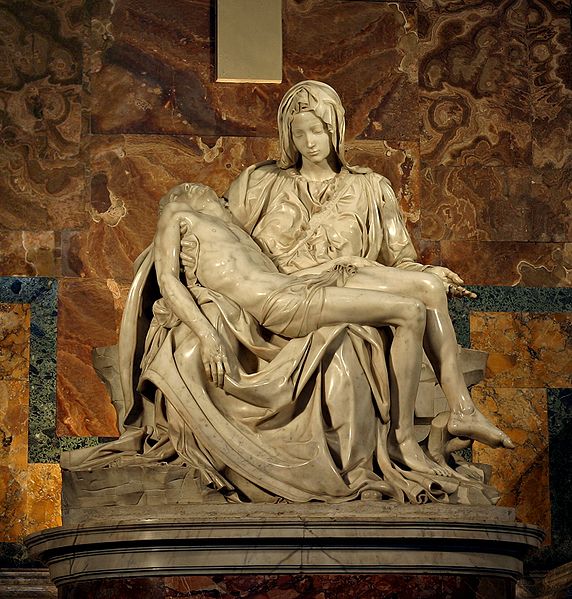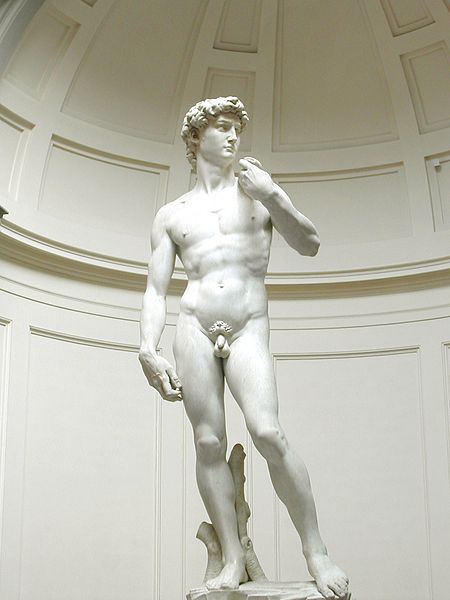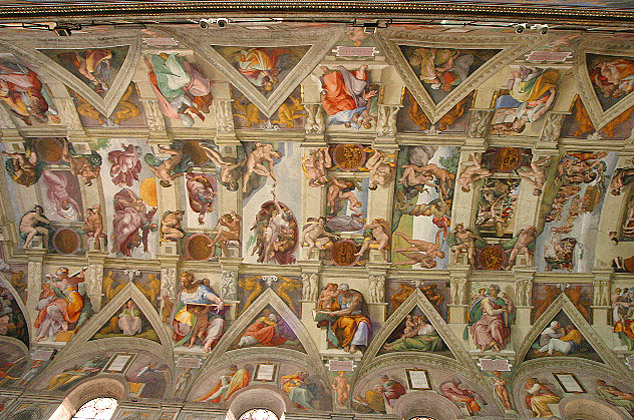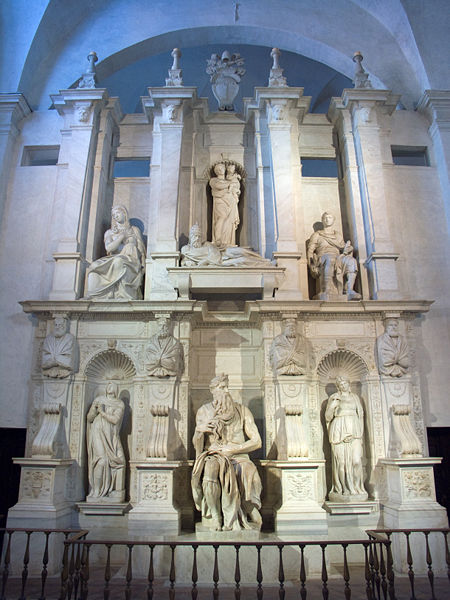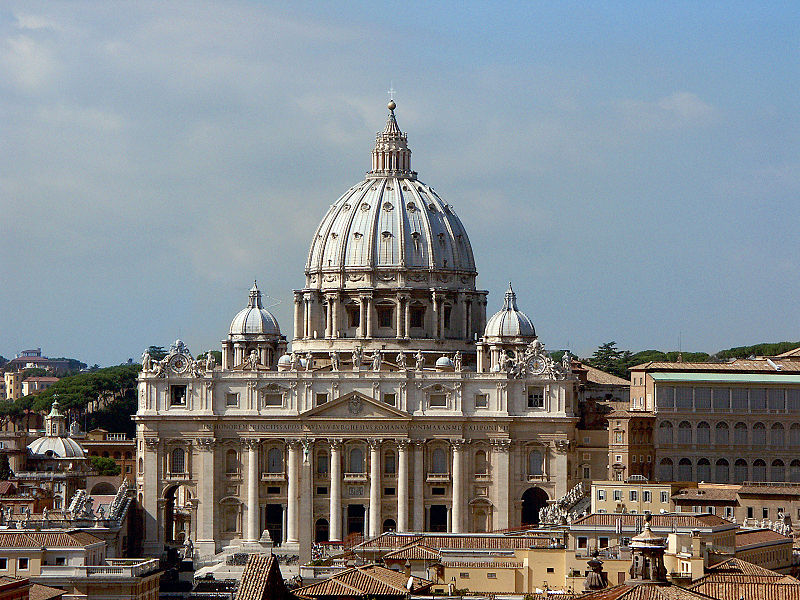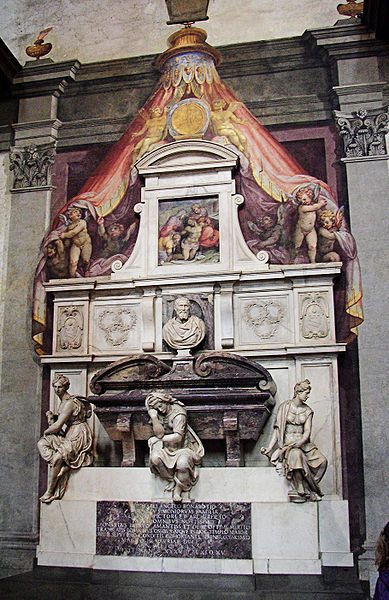<Back to Index>
- Optician Joseph von Fraunhofer, 1787
- Painter, Sculptor, Architect, Poet and Engineer Michelangelo di Lodovico Buonarroti Simoni, 1475
- Historian and Statesman Francesco Guicciardini, 1483
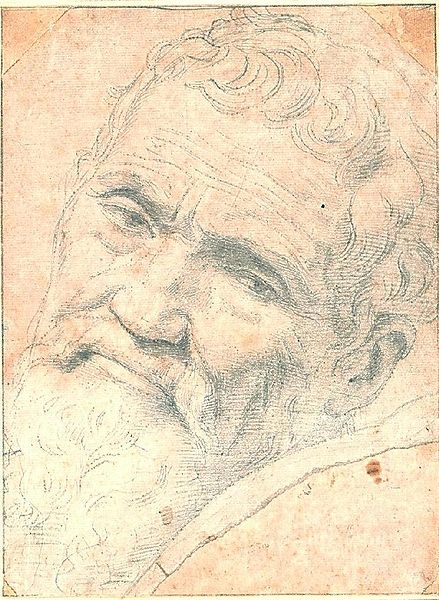
Michelangelo di Lodovico Buonarroti Simoni (6 March 1475 – 18 February 1564), commonly known as Michelangelo, was an Italian Renaissance painter, sculptor, architect, poet, and engineer. Despite making few forays beyond the arts, his versatility in the disciplines he took up was of such a high order that he is often considered a contender for the title of the archetypal Renaissance man, along with his rival and fellow Italian Leonardo da Vinci.
Michelangelo's output in every field during his long life was prodigious;
when the sheer volume of correspondence, sketches, and reminiscences
that survive is also taken into account, he is the best-documented
artist of the 16th century. Two of his best-known works, the Pietà and David,
were sculpted before he turned thirty. Despite his low opinion of
painting, Michelangelo also created two of the most influential works in fresco in the history of Western art: the scenes from Genesis on the ceiling and The Last Judgment on the altar wall of the Sistine Chapel in Rome. As an architect, Michelangelo pioneered the Mannerist style at the Laurentian Library. At 74 he succeeded Antonio da Sangallo the Younger as the architect of Saint Peter's Basilica.
In
a demonstration of Michelangelo's unique standing, he was the first
Western artist whose biography was published while he was alive. Two biographies were published of him during his lifetime; one of them, by Giorgio Vasari, proposed that he was the pinnacle of all artistic achievement since the beginning of the Renaissance, a viewpoint that continued to have currency in art history for centuries. In his lifetime he was also often called Il Divino ("the divine one"). One of the qualities most admired by his contemporaries was his terribilità,
a sense of awe-inspiring grandeur, and it was the attempts of
subsequent artists to imitate Michelangelo's impassioned and highly
personal style that resulted in Mannerism, the next major movement in Western art after the High Renaissance. Michelangelo was born on 6 March 1475 in Caprese near Arezzo, Tuscany. His
family had for several generations been small-scale bankers in Florence
but his father, Lodovico di Leonardo di Buonarroti di Simoni, failed to
maintain the bank's financial status, and held occasional government
positions. At the time of Michelangelo's birth, his father was the Judicial administrator of the small town of Caprese and local administrator of Chiusi. Michelangelo's mother was Francesca di Neri del Miniato di Siena. Several
months after Michelangelo's birth the family returned to Florence where
Michelangelo was raised. At later times, during the prolonged illness
and after the death of his mother when he was seven years old,
Michelangelo lived with a stonecutter and his wife and family in the
town of Settignano where his father owned a marble quarry and a small farm. Michelangelo's father sent him to study grammar with the Humanist Francesco da Urbino in Florence as a young boy. The
young artist, however, showed no interest in his schooling, preferring
to copy paintings from churches and seek the company of painters. At thirteen, Michelangelo was apprenticed to the painter Domenico Ghirlandaio. When in 1489 Lorenzo de' Medici, de facto ruler of Florence, asked Ghirlandaio for his two best pupils, Ghirlandaio sent Michelangelo and Francesco Granacci. From 1490 to 1492, Michelangelo attended the Humanist academy which the Medici had founded along Neo Platonic lines. Michelangelo studied sculpture under Bertoldo di Giovanni. At the academy, both Michelangelo's outlook and his art were subject to the influence of many of the most prominent philosophers and writers of the day including Marsilio Ficino, Pico della Mirandola and Angelo Poliziano. At this time Michelangelo sculpted the reliefs Madonna of the Steps (1490–1492) and Battle of the Centaurs (1491–1492). The latter was based on a theme suggested by Poliziano and was commissioned by Lorenzo de Medici. While both were apprenticed to Bertoldo di Giovanni, Pietro Torrigiano struck
the 17 year old on the nose, and thus caused that disfigurement which
is so conspicuous in all the portraits of Michelangelo. Lorenzo de' Medici's death on 8 April 1492, brought a reversal of Michelangelo's circumstances. Michelangelo left the security of the Medici court and returned to his father's house. In the following months he carved a wooden crucifix (1493), as a gift to the prior of the Florentine church of Santo Spirito, who had permitted him some studies of anatomy on the corpses of the church's hospital. Between 1493 and 1494 he bought a block of marble for a larger than life statue of Hercules, which was sent to France and subsequently disappeared sometime circa 1700s. On 20 January 1494, after heavy snowfalls, Lorenzo's heir, Piero de Medici, commissioned a snow statue, and Michelangelo again entered the court of the Medici. In the same year, the Medici were expelled from Florence as the result of the rise of Savonarola. Michelangelo left the city before the end of the political upheaval, moving to Venice and then to Bologna. In Bologna he was commissioned to finish the carving of the last small figures of the Shrine of St. Dominic,
in the church dedicated to that saint. Towards the end of 1494, the
political situation in Florence was calmer. The city, previously under
threat from the French, was no longer in danger as Charles VIII had
suffered defeats. Michelangelo returned to Florence but received no
commissions from the new city government under Savonarola. He returned
to the employment of the Medici. During the half year he spent in Florence he worked on two small statues, a child St. John the Baptist and a sleeping Cupid. According to Condivi, Lorenzo di Pierfrancesco de' Medici, for whom Michelangelo had sculpted St. John the Baptist,
asked that Michelangelo "fix it so that it looked as if it had been
buried" so he could "send it to Rome…pass [it off as] an ancient work
and…sell it much better." Both Lorenzo and Michelangelo were
unwittingly cheated out of the real value of the piece by a middleman.
Cardinal Raffaele Riario,
to whom Lorenzo had sold it, discovered that it was a fraud, but was so
impressed by the quality of the sculpture that he invited the artist to
Rome. This
apparent success in selling his sculpture abroad as well as the
conservative Florentine situation may have encouraged Michelangelo to
accept the prelate's invitation. Michelangelo arrived in Rome 25 June 1496 at the age of 21. On 4 July of the same year, he began work on a commission for Cardinal Raffaele Riario, an over-life-size statue of the Roman wine god, Bacchus.
However, upon completion, the work was rejected by the cardinal, and
subsequently entered the collection of the banker Jacopo Galli, for his
garden. In November of 1497, the French ambassador in the Holy See commissioned one of his most famous works, the Pietà and
the contract was agreed upon in August of the following year. In Rome, Michelangelo lived near the church of Santa Maria di Loreto. Here, according to the legend, he fell in love with Vittoria Colonna, marquise of Pescara and a poet. It is also during this period that skeptics allege Michelangelo executed the sculpture Laocoön and His Sons which resides in the Vatican. Michelangelo returned to Florence in 1499–1501. Things were changing in the republic after the fall of anti-Renaissance Priest and leader of Florence, Girolamo Savonarola (executed in 1498) and the rise of the gonfaloniere Pier Soderini. He was asked by the consuls of the Guild of Wool to complete an unfinished project begun 40 years earlier by Agostino di Duccio:
a colossal statue portraying David as a symbol of Florentine freedom,
to be placed in the Piazza della Signoria, in front of the Palazzo Vecchio. Michelangelo responded by completing his most famous work, the Statue of David in 1504. Also during this period, Michelangelo painted the Holy Family and St John, also known as the Doni Tondo or the Holy Family of the Tribune:
it was commissioned for the marriage of Angelo Doni and Maddalena
Strozzi and in the 17th century hung in the room known as the Tribune
in the Uffizi. He also may have painted the Madonna and Child with John the Baptist, known as the Manchester Madonna and now in the National Gallery, London. In 1505 Michelangelo was invited back to Rome by the newly elected Pope Julius II. He was commissioned to build the Pope's tomb.
Under the patronage of the Pope, Michelangelo had to constantly stop
work on the tomb in order to accomplish numerous other tasks. Because
of these interruptions, Michelangelo worked on the tomb for 40 years.
The tomb, of which the central feature is Michelangelo's statue of Moses, was never finished to Michelangelo's satisfaction. It is located in the Church of S. Pietro in Vincoli in Rome. During
the same period, Michelangelo took the commission to paint the ceiling
of the Sistine Chapel, which took approximately four years to complete
(1508–1512). The composition eventually contained over 300 figures and had at its center nine episodes from the Book of Genesis,
divided into three groups: God's Creation of the Earth; God's Creation
of Humankind and their fall from God's grace; and lastly, the state of
Humanity as represented by Noah and
his family. In 1513 Pope Julius II died and his successor Pope Leo X, a Medici, commissioned Michelangelo to reconstruct the façade of the basilica of San Lorenzo in Florence and
to adorn it with sculptures. Michelangelo agreed reluctantly. The three
years he spent in creating drawings and models for the facade, as well
as attempting to open a new marble quarry at Pietrasanta specifically
for the project, were among the most frustrating in his career, as work
was abruptly cancelled by his financially-strapped patrons before any
real progress had been made. The basilica lacks a facade to this day. Apparently
not the least embarrassed by this turnabout, the Medici later came back
to Michelangelo with another grand proposal, this time for a family
funerary chapel in the basilica of San Lorenzo.
Fortunately for posterity, this project, occupying the artist for much
of the 1520s and 1530s, was more fully realized. Though still
incomplete, it is the best example we have of the integration of the
artist's sculptural and architectural vision, since Michelangelo
created both the major sculptures as well as the interior plan.
In 1527, the Florentine citizens, encouraged by the sack of Rome, threw out the Medici and
restored the republic. A siege of the city ensued, and Michelangelo
went to the aid of his beloved Florence by working on the city's
fortifications from 1528 to 1529. The city fell in 1530 and the Medici
were restored to power. Completely out of sympathy with the repressive
reign of the ducal Medici, Michelangelo left Florence for good in the
mid-1530s, leaving assistants to complete the Medici chapel. Years
later his body was brought back from Rome for interment at the Basilica di Santa Croce, fulfilling the maestro's last request to be buried in his beloved Tuscany. The fresco of The Last Judgment on the altar wall of the Sistine Chapel was commissioned by Pope Clement VII,
who died shortly after assigning the commission. Paul III was
instrumental in seeing that Michelangelo began and completed the
project. Michelangelo labored on the project from 1534 to October 1541.
The work is massive and spans the entire wall behind the altar of the
Sistine Chapel. The Last Judgment is
a depiction of the second coming of Christ and the apocalypse; where
the souls of humanity rise and are assigned to their various fates, as
judged by Christ, surrounded by the Saints. In 1546, Michelangelo was appointed architect of St. Peter's Basilica in
the Vatican, and designed its dome. As St. Peter's was progressing
there was concern that Michelangelo would pass away before the dome was
finished. However, once building commenced on the lower part of the
dome, the supporting ring, the completion of the design was inevitable. On
7 December 2007, Michelangelo's red chalk sketch for the dome of St
Peter's Basilica, his last before his 1564 death, was discovered in the
Vatican archives. It is extremely rare, since he destroyed his designs
later in life. The sketch is a partial plan for one of the radial
columns of the cupola drum of Saint Peter's. Michelangelo worked on many projects that had been started by other men, most notably in his work at St Peter's Basilica, Rome. The Campidoglio, designed by Michelangelo during the same period, rationalized the structures and spaces of Rome's Capitoline Hill.
Its shape, more a rhomboid than a square, was intended to counteract
the effects of perspective. The major Florentine architectural projects
by Michelangelo are the unexecuted façade for the Basilica of San Lorenzo, Florence and the Medici Chapel (Capella Medicea) and Laurentian Library there, and the fortifications of Florence. The major Roman projects are St. Peter's, Palazzo Farnese, San Giovanni dei Fiorentini, the Sforza Chapel (Capella Sforza) in the Basilica di Santa Maria Maggiore, Porta Pia and Santa Maria degli Angeli.
